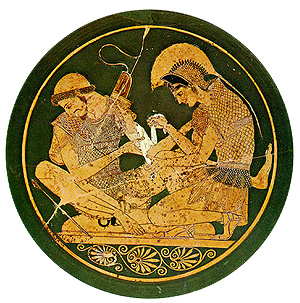Exploring
Illness
Across
Time and Place
c u l t u r e s
s y m p t o m s
Classical Greek medicine interpreted the deformation of a limb, accompanied by pain and discoloration, with or without a wound, to be evidence of a fractured bone. If a person had these symptoms, a doctor first examined the limb by feeling for the site of the fracture or looking at the location of the deformation. After locating the break, a doctor would attempt to set the bones back into the position they had prior to the injury. He would then bandage and splint the injured limb. The patient's diet should be moderated early in the healing process. Splints would be adjusted every few days until the fracture healed.
The Hippocratic treatise "On Fractures" provides an excellent understanding of how doctors understood broken bones. It begins this way: "In treating fractures and dislocations, the physician must make the extension as straight as possible, for this is the most natural direction. ... Those, then, who act in such cases without deliberation, for the most part do not fall into any great mistake, for the person who is to have his arm bound, presents it in the proper position from necessity" (1)
After setting the bone, the doctor would bandage the arm, taking care not to make the bandages too tight. Three days later, the doctor would rebandage the arm, removing the old bandages and again ensuring that the bandages were tight enough to hold the bones in their natural position, but not too constrictive. One week after the injury, the doctor would apply splints around the fracture to hold the limb in the proper position. Bandages were made of cloth or wool, and splints of wood or reeds.
When you have applied the bandages, you must adjust the splints all around the limb, and secure them secure them with strings so loose as just to keep them in their place, without the application of the splints contributing at all to the compression of the arm. After this the pain and recovery should proceed as in the preceding periods of the bandaging. But if, on the third day, the patient say that the bandaging is loose, you must then fasten the splints, especially at the fracture, but also elsewhere, wherever the bandaging is rather loose than tight. The splint should be thickest where the fracture protrudes, but it should not be much more so than elsewhere. Particular attention should be paid to the line of the arm corresponding to the thumb, so that no splint be laid on it, but upon each side of it, nor in the line of the little finger where the bone is prominent at the wrist, but on each side of it. And if it be found necessary that splints should be applied in these directions at the seat of the fracture, they should be made shorter than the others, so as that they may not reach the bones which are prominent at the wrist, for otherwise there is danger of ulceration, and of the tendons being laid bare. The splints should be adjusted anew every third day, in a very gentle manner, always keeping in mind that the object of the splints is to maintain the lower bandages in their place, and that they are not needed in order to contribute to the compression. (2)

After this, a patient would have his arm hung in shawl to help support the broken arm.
The Hippocratic texts also asserted that diet was essential to healing during and after injury. "A diet slightly restricted will be sufficient in those cases in which there was no external wound at first, or when the bone does not protrude; but one should live rather sparingly until the tenth day, as being now deprived of exercise; and tender articles of food should be used, such as moderately loosen the bowels; but one should abstain altogether from flesh and wine, and then by degrees resume a more nourishing diet." This diet would help the patient heal, while not being overly rough for him in his damaged state.
An illustration of the treatment of an arm wound exists from approximately 490 B.C.E. This picture shows Achillies treating Patrokolos, an image from the homeric epics. He appears to be applying a tourniquet.
Notes
1. Adams, Francis (translator), The Genuine Works of Hippocrates. New York: William Wood and Company, 1886. Volume 2, p. 35. The principles of treating arm fractures were considered to apply to kinds of fractures.
2. ibid, p. 41. .